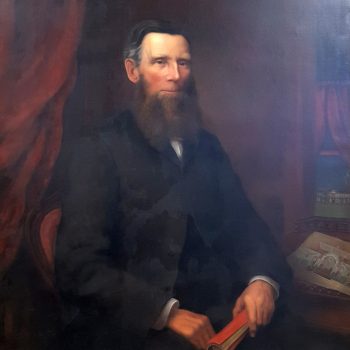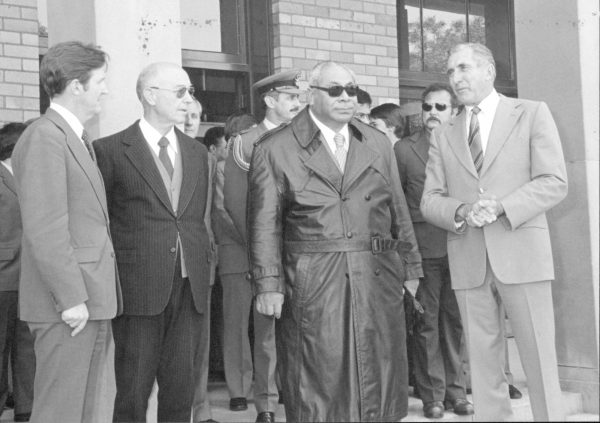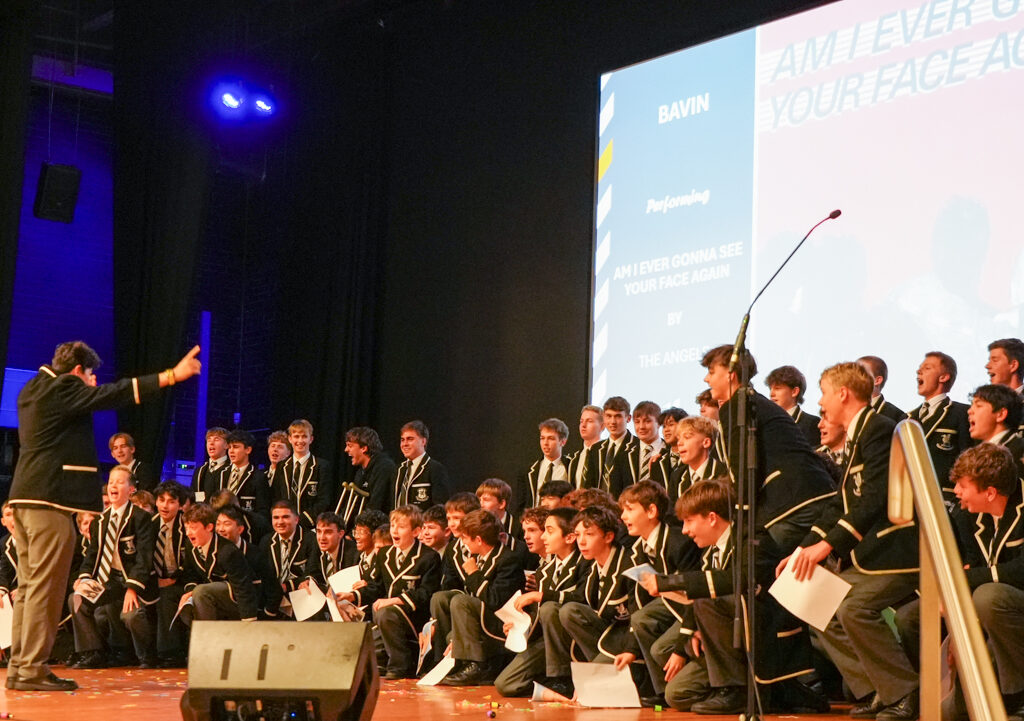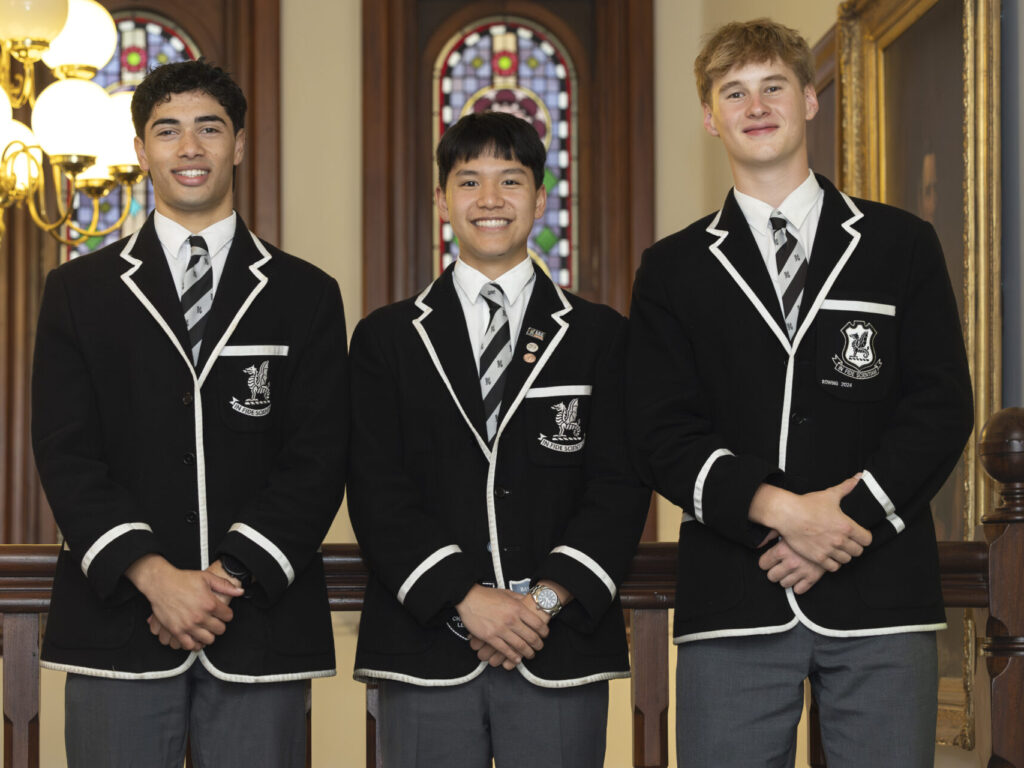The history of Newington’s Houses
Start of the House system
At the 1931 Speech Day, the new Headmaster, Philip Le Couteur, announced that a House system would be introduced, as part of a range of innovations, with a competition shield presented by a parent, Mr A.E. Clarke.
The new House system aimed at ‘improving the standard of the school, both in sport and class-work, by providing for competitive effort in every branch of school activity’, as The Newingtonian reported in September 1932 after the system’s first term of operation.
Initially, half of the House competition points were applied to sport, the other half being for class-work and debating, while a system of averages was employed ‘by which the result will be affected by the individual efforts of every boy in the House’. Later, however, the sporting competition came to dominate.
It was hoped that each House would develop an esprit de corps, encouraging all boys to strive, not just those with talents in particular areas. At this period, also, GPS sporting competition was limited to the senior teams: thus the House matches would enable the younger boys to develop their talents more readily.
The Houses also competed less formally in their representation in the College’s senior sports teams, reporting proudly in The Newingtonian on who had been selected for the ‘Firsts’ in the major sports.
The four Houses established in 1932 comprised three for the day boys — Manton, Fletcher and Kelynack, names chosen by the College Council in honour of the first Presidents of the College — and one for the boarders, named School House. The initial House colours were Manton: green; Fletcher: royal blue; Kelynack: maroon; and School House: light blue.
Changes
Even at that early stage, changes to the House structure were anticipated: ‘As the school increases in numbers, other Houses will be formed and named in honour of succeeding Presidents’, The Newingtonian noted.
The first change in the senior school was the result of the boarders’ habitual dominance of the House competition. In 1946, School House became two boarders’ Houses, Moulton and Prescott, named in honour of one of Newington’s founders and last President (Moulton) and its first modern Headmaster (Prescott).
In 1954, a further three day boy Houses were added, so that each would have approximately the same number of members. Named Johnstone, Metcalfe and Le Couteur, they honoured the first two 19th century ‘Head Masters’ (second-in-charge under the Presidents) and, of course, the founder of the House system. At the same time, the debating competition was revived, a tennis competition was added, a complicated system of form rankings was used for scholarly competition, and points were awarded for ranks in the Cadet Corps and Air Training Corps.
This structure and system were short-lived. In 1957 the Houses were amalgamated into four, with paired names: Moulton-Prescott (boarders), Kelynack-Johnstone, Manton-Le Couteur and Fletcher-Metcalfe (day boys). At the same time, the House competition system was simplified, with marks awarded ‘only for events which lend themselves to direct competition’, in practice a range of sports plus debating.
Four years later, membership of the day boy Houses was reorganised of the basis of residence, while Johnstone and Kelynack briefly became separate Houses again. In 1962, the House competition was suspended amid concerns that the sporting program was too full and that the competition promoted ill-feeling between boarders and day boys. New Headmaster Douglas Trathen, keen to promote participation, reinstated it the next year and in 1965 extended it to cover nine sports plus debating.
More importantly, in 1964 Trathen introduced a House tutor system, which is the origin of today’s system of pastoral care.
The final change in the House structure before this year took place in 1974. ‘Chiefly with a view to enabling more boys to participate in various activities,’ as Headmaster Tony Rae reported, the senior school was divided again into eight Houses, this time with boarders and day boys distributed through all of them. At the same time the House competition was strengthened, and chess and seven-a-side rugby were added.
And now
In 2021, as a key element in efforts to strengthen the system of pastoral care, the College decided to expand the Houses in the senior school from eight to sixteen in 2022. At heart, the aim is that ‘boys will develop stronger pastoral relationships with their Head of House when the Head of House only has a little over half as many boys to care for,’ as Headmaster Michael Parker put it when announcing the change in May.
But what would the new Houses be called?
An early decision was that we would move away from the traditional practice of naming Houses after Presidents and Headmasters. Another principle was that the people after whom the new Houses would be named should not still be living.
In the end, high importance was placed on honouring pioneering and significant women in the College’s long history. Hence, four of the new Houses are named Gilligan, Whitaker, Cooper and Morrison.
Another priority was to honour Newington’s long and close association with our brother school in Tonga, Tupou College. Thus, one of the new Houses is named Tupou. The name also recognises the College’s only Old Boy head of state, the late King Tāufaʻāhau Tupou IV (ON 1936).
Finally, it was decided to honour Old Newingtonians who excelled in their callings in later life or contributed positively on the national or world stage. Hundreds of the College’s alumni might be regarded as fitting this description, and the choices would inevitably be difficult and subjective.
A rigorous process whittled the possible names down to a shortlist, from which emerged the names Bavin, Mackay and Clunies Ross.
The Preparatory Schools
Newington’s two Preparatory Schools have each had Houses since soon after their establishment. While not affected by the latest change in the senior school, their Houses are part of the College’s House story.
Wyvern House, which had been established as a separate preparatory school in 1939, was initially divided into ‘Groups’: the Bears, Tigers and Wolves.
By 1942 Wyvern House had adopted the House system, with its four Houses named identically to those in the senior school. In 1946 they were reduced to three and the next year their names were changed to Coates, Williams and Lucas, in honour of three of the 19th century Head Masters. In 1954 Howe House, honouring another such Head Master, was added.
The House competition was initially limited to sports matches and events, but was extended in 1947 to include class work, conduct (including demerits for poor conduct) and representing the school in inter-school competition. That year the Parents’ and Friends’ Association presented a shield for to be awarded to the premier House.
The Lindfield Preparatory School’s House system was introduced in 1958, the year after the school’s foundation at its original campus in Killara. The Houses established, Kingswood and Rydal, were named, with permission, after great Methodist schools in England and Wales, respectively. A competition shield was presented by a parent, Mr K.G. Lober, with the competition combining points for good work and conduct, physical culture and sporting events.
Lindfield’s House structure has been most stable of Newington’s campuses, with the same two Houses continuing today.
The people behind the names
Stanmore senior campus
Manton
Rev. John Allen Manton founded Newington College at Newington House, Silverwater, in 1863, and served as its first Principal or President until his death in September the following year.
For more information, see the Australian Dictionary of Biography entry for Rev. John Allen Manton.

Fletcher (pictured)
Rev. Joseph Horner Fletcher served as Newington’s President from 1865 to 1887. He led the planning, fundraising and building of the new College at Stanmore and the move there in 1880.
For more information, see the Australian Dictionary of Biography entry for Rev. Joseph Horner Fletcher.
Kelynack
Rev. Dr. William Kelynack was one of the leading Methodist churchmen of his era and served as Newington’s President from 1887 until his death in 1891.
For more information, see the Australian Dictionary of Biography entry for Rev. Dr. William Kelynack.
Moulton
Rev. Dr. James Egan Moulton helped found Newington College, acting as its initial Head Master in 1863. During his long service in Tonga, he founded Tupou College. He served as Newington’s President from 1893 to 1900.
For more information, see the Australian Dictionary of Biography entry for Rev. Dr. James Egan Moulton.
Prescott
Rev. Dr. Charles John Prescott was Newington’s first modern Headmaster, combining the previous roles of President and Head Master. Serving from 1900 to 1931, he led the College through the trauma of the First World War.
For more information, see the Australian Dictionary of Biography entry for Rev. Dr. Charles John Prescott.
Johnstone
Thomas Johnston (now considered the correct spelling) had been appointed as Newington’s first Head Master and arrived from England in November 1863. A fine classical scholar, he served until the end of 1866.
Metcalfe
George Metcalfe was Newington’s Head Master from 1867 to 1869. The first university graduate to teach at the College, he also introduced an early form of Australian Rules Football: he had been Vice-President of the Geelong Football Club in 1861, which had been founded two years earlier. After leaving Newington he founded a college in Goulburn and married Annie Gilligan, after whom one of the new Houses is named.
Le Couteur
Philip Ridgway Le Couteur was Newington’s Headmaster from 1931 to 1948. He led the College through the challenges of the Depression, established Wyvern House and oversaw remarkable growth in student numbers.
For more information, see the Australian Dictionary of Biography entry for Philip Ridgway Le Couteur.
Gilligan
Annie Gilligan was the College’s first female member of staff, appointed on the College’s foundation in 1863. In the role of Housekeeper during the College’s crucial first six years, she had charge of accommodation and catering and of the domestic staff, all-important functions in an all-boarding school. She was described as ‘a great favourite with the boys, having an estimable blend of firmness and kindness’, while an obituary noted that, ‘Of commanding appearance and manner, she exerted a great influence over collegians.’
Whitaker
Edith Whitaker was Newington’s first female subject head, and reportedly the first in the GPS. She was also our earliest identified female teacher. An experienced teacher and former principal in Perth and Sydney, she was appointed as Head of English at Newington in 1942, as part of an effort to replace male teachers who had enlisted. Quickly proving that she herself a strong disciplinarian, she won the esteem and respect of the senior boys — ‘who naturally received the coming of a lady teacher with askance’, as the Council put it. She achieved very fine exam results, as well as influencing the boys’ character, good speech, courtesy and general bearing. When she retired from Newington in 1949, the Council passed a special resolution in recognition of her service and achievements, eighty of her current and former students joined the Council for her farewell dinner, and the Old Boys presented her with a silver tea pot and tray.
Cooper
Sister Margaret Cooper served as the Wyvern House Matron (school nurse) from 1958 and assumed the same role for the senior school as well when the School Sick Bay moved to Wyvern House (now the Le Couteur centre), remaining in this role until her death in 1981. She implemented modern health care standards in the Sick Bay and collaborated with Dr Roger Davidson OAM (ON 1940) over many years in the Saturday Sports Clinic. Well-liked and highly regarded for ‘her long years of skilled, cheerful and reliable service’, as Headmaster Tony Rae put it, she was also recognised for providing much-valued pastoral and emotional support to students before there were strong College programs for this purpose.
Morrison
Appointed to head the Library and Resources Centre in 1978, Jan Morrison recruited a department of professional staff and transformed the Library and its services, including introducing computer cataloguing, building up audio-visual resources and services, and overseeing the Library’s refurbishment and extension, among a range of innovations. She also played a major role in performing arts, including as stage manager for numerous productions. Known as ‘Conan the Librarian’ to many of the students, she was a popular and respected professional and department head. She was forced to retire mid-career due to ill-health in 1996.

Tupou (pictured)
The name Tupou recognises Newington’s deep connections with Tupou College, our brother school in Tonga, which extend back to the latter’s foundation in 1866 by Rev. James Egan Moulton (one of Newington’s founders) under the patronage of King George Tupou I.
The name also recognises the College’s only Old Boy head of state, the late King Tāufaʻāhau Tupou IV (ON 1936). The then Prince attended the College. Where he was known as George Taufa’ or Taufa’ahau, from 1933 to 1936. He was a fine student, The Newingtonian noting his ‘quiet and studious nature’ and ‘his extraordinary powers of concentration [that] helped him to succeed in every sphere of the scholastic side of his School life.’ He was also a keen and accomplished sportsman, notably in athletics.
After university studies in Sydney, the Prince embarked on his life of public service in Tonga, serving from 1943 as a minister in the Tongan Government and, from 1949, as Premier. He ascended the throne at the end of 1965, following the death of Queen Salote Tupou III, and reigned until his death in 2006.
Bavin
Sir Thomas Rainsford Bavin (ON 1890) held the highest political office of any Old Newingtonian so far, serving as Premier of New South Wales from 1927 to 1930, among other things introducing a progressive tax system and navigating the early challenges of the Depression, as part of a parliamentary career from 1917 to 1935. Also a successful barrister, he subsequently served as a Supreme Court judge.
Born in New Zealand, Bavin had come to Newington in 1889 aged 15 and remained to the end of the following year. Unfortunately we otherwise know little of his time at school.
For more information, see the Australian Dictionary of Biography entry for Sir Thomas Rainsford Bavin.
Mackay
Sir Iven Giffard Mackay (ON 1901) held the highest armed services rank of any Old Newingtonian so far and, along with ‘Sandy’ Pearson (ON 1936), may be regarded as Newington’s greatest soldier. He gave distinguished service in the First World War, including acts of incredible personal bravery in the trench fighting at Lone Pine, Gallipoli, and learning the general’s craft on the Western Front. A school teacher and university lecturer by profession, he served as Cranbrook’s headmaster in the 1930s. In the Second World War, he commanded the 6th Australian Division in the Middle East, masterminding the textbook capture of Bardia, along with 40,000 prisoners, resulting in a huge boost to Allied morale worldwide. He subsequently commanded Australia’s Home Forces, then New Guinea Force, and, after the war, served as Australia’s first High Commissioner to India.
Mackay attended Newington from 1897 to early 1901. ‘Distinguished from the first for his hard and solid work, both in school and out’, as The Newingtonian reported, he passed the Senior Examination ‘very creditably’, served as a Prefect and as a Sergeant in the Cadets and was a prominent debater. He was a member of each of the three senior sporting teams — cricket, rugby and rifle shooting — for three years, winning Triple Colours and two rugby honour caps.
For more information, see the Australian Dictionary of Biography entry for Sir Iven Giffard Mackay.
Clunies Ross
Sir (William) Ian Clunies Ross (ON 1916) is regarded as one of the most influential figures in Australian science and has been described as the architect of its post-war boom through his chairmanship of the CSIRO. While a good, though not great, research scientist in his chosen field of veterinary science, he was a superlative administrator and communicator. His leadership was visionary and strategic, directed to the practical application of science to achieve benefits in agriculture and industry. A prominent public figure, he was relentless in his promotion of scientific research. For more than two decades, his face graced the first version of the $50 note.
Clunies Ross attended Newington from 1912 to 1916. A fine scholar, he achieved a University Exhibition in Agricultural Science along with his Leaving Certificate. In sport he captained the 3rd XI and played in the 2nd XV. He played the part of Mr Box in the Newington Dramatic Society’s 1916 production of ‘Cox and Box’.
For more information, see the Australian Dictionary of Biography entry for Sir (William) Ian Clunies Ross.
Wyvern House
Coates
Joseph Coates was one of Newington’s first teachers and served as Head Master from 1877 to 1883. He founded the Cadets and the sports of rugby and shooting at the College. In 1883 he was appointed as the first headmaster of Sydney Boys’ High School.
For more information, see the Australian Dictionary of Biography entry for Joseph Coates.
Williams
William Henry Williams was Newington’s Head Master from 1884 to 1892. The most academically accomplished Head so far, he broadened the curriculum in the humanities and sciences and introduced a stream of ‘modern’ (as opposed to classics) subjects.
For more information, see the Australian Dictionary of Biography entry for William Henry Williams.
Lucas
Arthur Henry Shakespeare Lucas was Newington’s Head Master from 1893 to 1898. A noted biologist and gifted teacher and administrator, he further improved the College’s academic reputation. He subsequently taught and served as Headmaster at Sydney Grammar School.
For more information, see the Australian Dictionary of Biography entry for Arthur Henry Shakespeare Lucas.
Howe
Dr Michael C Howe was Newington’s Head Master from 1869 to 1877. A distinguished classics scholar and popular teacher, he promoted academic rigour and oversaw Newington’s remarkable early successes in the public examinations and university admissions.
Lindfield Prep School
Kingswood
The Kingswood School was founded in Bath, England, in 1748 by John Wesley, the founder of Methodism, and is the oldest Methodist school in the world. Besides it being a great Methodist educational institution, and an inspiration for Newington’s founders, four of the significant figures in Newington’s history — Moulton, Fletcher, Lucas and Prescott — were educated there.
Rydal
Rydal Mount (later Rydal School and now Rydal Penrhos School) was founded at Colwyn Bay, North Wales, in 1885, and is the only Methodist school in Wales. Founded as a boys’ boarding school, it started admitting girls in the 1960s and merged with a girls’ school, Penrhos College, in 1999.



